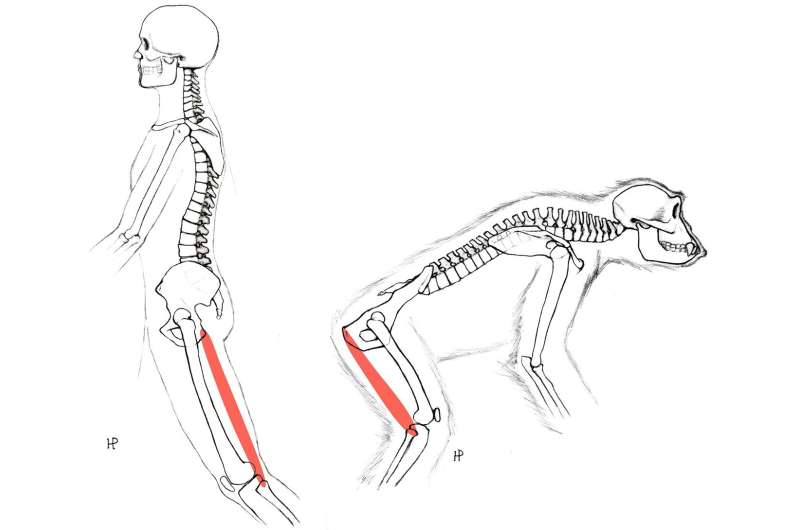April 3, 2018 report
Study shows changes in anatomy would have made walking easier without reducing muscles for climbing in early hominins

An international team of researchers has found evidence that suggests evolutionary changes in anatomy would have made walking more economical without reducing utility of muscles for climbing in early hominins. In their paper published in Proceedings of the National Academy of Sciences, the group describes studying bones and fossils from human ancestors and how they fit together to determine their walking and climbing abilities.
How and when early human ancestors first began walking upright remains a topic of debate among scientists, and research continues to find the answer. In this new effort, the researchers took another look at conventional ideas suggesting that the first hominins to walk upright likely did so extremely awkwardly, as they retained physical features that would allow them to escape enemies by climbing trees. The researchers suggested that if that were the case, those early hominins would not have survived.
To prove their theory, they began by taking a closer look at human gait and comparing the data with how apes and monkeys walk. They noted that the angle at which the leg and hip bones meet are different between the species, which means that walking upright for apes and monkeys places a lot of stress on thigh muscles, hamstrings and the knees. A shorter ischium (curved bone at the base of the pelvis) in humans allows for full extension without undue pressure on other leg parts. The net result, the researchers noted, is an ability to walk not only upright, but more efficiently.
The researchers then looked at the anatomy of ancient hominins—going all the way back to Lucy. All of the members of Australopithecus, they noted, had a full range of motion, allowing them to walk upright—even as they conserved traits that allowed them to climb much better than today's humans. The researchers also found that an older hominin known as Ardi, who lived approximately 4.4 million years ago, had pelvic anatomy that allowed for walking upright almost as easily as modern humans, yet still had a long ischium. This, the team claims, shows that early hominins were able to walk upright and climb trees in relatively easy fashion—not clumsily, as others have suggested.
More information: Elaine E. Kozma et al. Hip extensor mechanics and the evolution of walking and climbing capabilities in humans, apes, and fossil hominins, Proceedings of the National Academy of Sciences (2018). DOI: 10.1073/pnas.1715120115
Abstract
The evolutionary emergence of humans' remarkably economical walking gait remains a focus of research and debate, but experimentally validated approaches linking locomotor capability to postcranial anatomy are limited. In this study, we integrated 3D morphometrics of hominoid pelvic shape with experimental measurements of hip kinematics and kinetics during walking and climbing, hamstring activity, and passive range of hip extension in humans, apes, and other primates to assess arboreal–terrestrial trade-offs in ischium morphology among living taxa. We show that hamstring-powered hip extension during habitual walking and climbing in living apes and humans is strongly predicted, and likely constrained, by the relative length and orientation of the ischium. Ape pelves permit greater extensor moments at the hip, enhancing climbing capability, but limit their range of hip extension, resulting in a crouched gait. Human pelves reduce hip extensor moments but permit a greater degree of hip extension, which greatly improves walking economy (i.e., distance traveled/energy consumed). Applying these results to fossil pelves suggests that early hominins differed from both humans and extant apes in having an economical walking gait without sacrificing climbing capability. Ardipithecus was capable of nearly human-like hip extension during bipedal walking, but retained the capacity for powerful, ape-like hip extension during vertical climbing. Hip extension capability was essentially human-like in Australopithecus afarensis and Australopithecus africanus, suggesting an economical walking gait but reduced mechanical advantage for powered hip extension during climbing.
Journal information: Proceedings of the National Academy of Sciences
© 2018 Phys.org


















